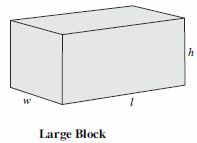General Information
Subject Area: X-Mathematics (former standards - 2008)
Grade: 7
Body of Knowledge: Geometry
Idea: Level 3: Strategic Thinking & Complex Reasoning
Supporting Idea: Geometry and Measurement - Geometry and Measurement
Date Adopted or Revised: 09/07
Content Complexity Rating:
Level 3: Strategic Thinking & Complex Reasoning
-
More Information
Date of Last Rating: 06/07
Status: State Board Approved - Archived
Assessed: Yes
Test Item Specifications
At Grade 7, this benchmark will be assessed using MC and GR items.
Clarification :
Students will determine the effects of changing dimensions on perimeter, circumference, area, and volume.
Students will solve problems involving the effects of changing dimensions on perimeter, circumference, area, and volume.
Students will determine the effects of changing dimensions on perimeter, circumference, area, and volume.
Students will solve problems involving the effects of changing dimensions on perimeter, circumference, area, and volume.
Content Limits :
Items that increase the dimensions of a figure should use scale factors that are whole numbers less than or equal to 25.
Items that decrease the dimensions of a figure should use scale factors of 1/2, 1/3, 1/4, 1/5, 1/10, 10%, 20%, 25%, or 50%. Distractors in MC items may exceed this limit.
Items assessing change in volume should only include right-rectangular prisms and right-circular cylinders.
Items will not assess changes in surface area.
Items that increase the dimensions of a figure should use scale factors that are whole numbers less than or equal to 25.
Items that decrease the dimensions of a figure should use scale factors of 1/2, 1/3, 1/4, 1/5, 1/10, 10%, 20%, 25%, or 50%. Distractors in MC items may exceed this limit.
Items assessing change in volume should only include right-rectangular prisms and right-circular cylinders.
Items will not assess changes in surface area.
Stimulus Attributes :
Items should be set in a real-world or mathematical context.
Items that are set in real-world context may use length and width as dimensions as well as base and height as dimensions.
Graphics should be used in most of these items, as appropriate.
Items should be set in a real-world or mathematical context.
Items that are set in real-world context may use length and width as dimensions as well as base and height as dimensions.
Graphics should be used in most of these items, as appropriate.
Sample Test Items (2)
| Test Item # | Question | Difficulty | Type |
| Sample Item 1 | Toni has a rectangular vegetable garden that measures 12 feet by 18 feet. She wants to reduce the area of her garden. If Toni reduces the dimensions of her garden to 12 feet by 9 feet, how will the area of the new garden compare to the area of the old garden? | N/A | MC: Multiple Choice |
| Sample Item 2 | Jeff is building walls using the building blocks shown below. The dimensions of the small blocks are 1/2 the size of the dimensions of the large blocks. Jeff’s wall has a length (l) of 5 large blocks and a height (h) of 2 large blocks. Building Blocks How many small blocks does Jeff need to build a wall with the same volume as the wall he made with large blocks? |
N/A | GR: Gridded-Response |
Related Resources
Virtual Manipulative
| Name | Description |
| Scale Factor | Explore the effect on perimeter and area of two rectangular shapes as the scale factor changes. |
Student Resources
Virtual Manipulative
| Name | Description |
| Scale Factor: | Explore the effect on perimeter and area of two rectangular shapes as the scale factor changes. |


